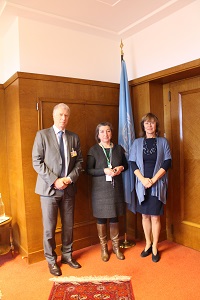
Countries cannot know whether they are successful in implementing the 2030 Agenda for Sustainable Development, and achieving the Sustainable Development Goals, unless success is defined and tracked. SDG indicators provide such a definition and something to track. As a result, indicators – including environmental ones – form the backbone of monitoring progress towards SDGs at the local, national, regional and global levels.
On 30 January 2019, in connection with the twenty-fourth session of the UNECE Committee on Environmental Policy in Geneva, the executive heads of the United Nations Economic Commission for Europe (UNECE), the European Office of the United Nations Environment Programme (UNEP/Europe) and the European Environment Agency (EEA) met as part of their long-standing common approach in support of national, regional and global reporting on the state of the environment.
UNECE, UNEP and EEA work together closely on environmental monitoring, reporting and assessment, thus supporting the achievement of SDGs. They have agreed to cooperate on establishing a regular environmental assessment process and extending the Shared Environmental Information System (SEIS) across the pan-European region supporting countries’ efforts to have SEIS in place by year 2021, as stated in the Ministerial Declaration from Batumi, Georgia (June 2016). According to the SEIS principles, information should be: managed as close as possible to its source; collected once and shared with others for many purposes; readily available to easily fulfil reporting obligations; easily accessible to all users; accessible to enable comparisons at the appropriate geographical scale and the participation of citizens; fully available to the general public and at national level in the relevant national language(s); and supported through common, free, open software standards. In pursuit of this goal, the three organizations have held regular high-level dialogues supported by coordination and information exchange meetings at the operational level.
The meeting of the executive heads on 30 January focused on the latest developments and opportunities in environmental monitoring, reporting and assessment and ways to further strengthen linkages between various networks involved in these areas. The meeting coincided with the successful completion of a mid-term review in support of the implementation of the outcomes of the
Eighth Environment for Europe Ministerial Conference, held in Batumi, Georgia in 2016. The mid-term review report demonstrated how the three organizations have strengthened cooperation and promoted the sharing of environmental information and streamlining assessment activities.
The SEIS mid-term review report confirmed that many countries across the pan-European region have continued to harmonize relevant environmental data flows and improve the quality of the selected environmental indicators and underpinning data flows since 2016. The report showcased the inherent value in continued monitoring of the establishment of SEIS through a regular self-assessment of progress, particularly helping to improve the use of relevant environmental data and information for multiple purposes, knowledge-based policy-making and better environmental governance.